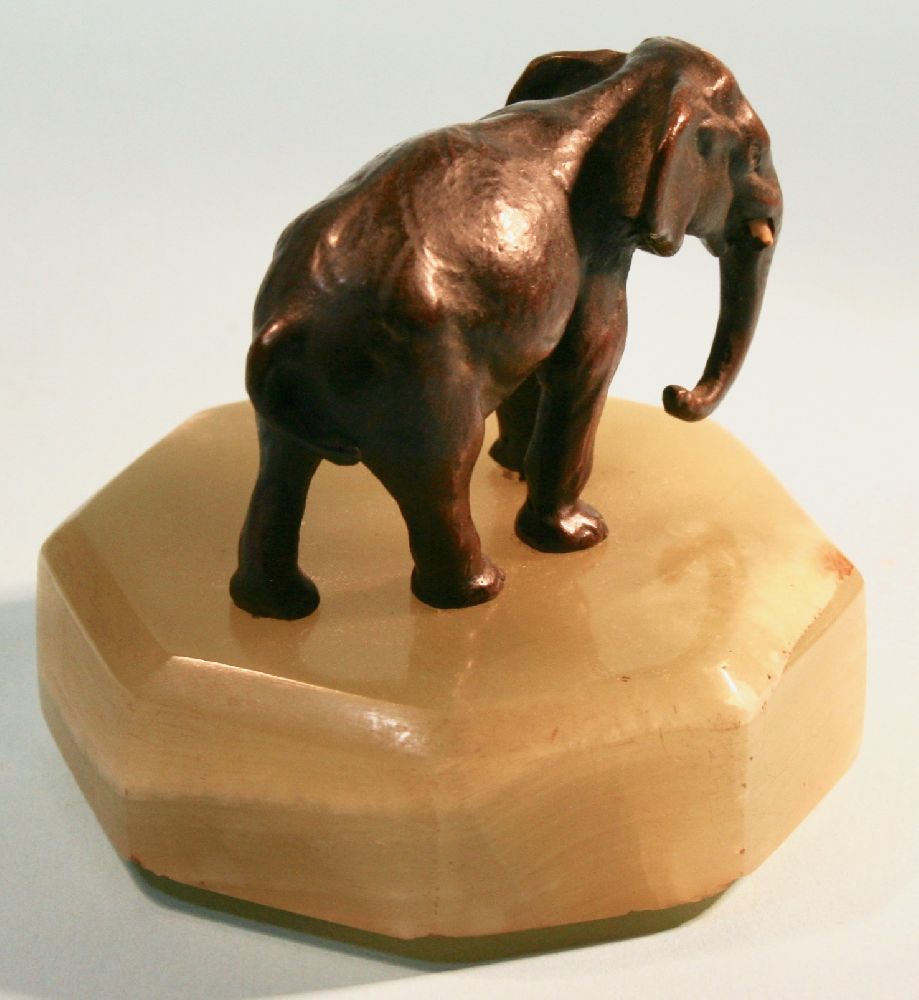

Title: Art Deco Elephant Sculpture Made Of Bronze And Marble
Shipping: $20.00
Artist: N/A
Period: 20th Century
History: N/A
Origin: North America > United States
Condition: Museum Quality
Item Date: N/A
Item ID: 6723
Consignment / Must check for availability / Behold this exquisite Art Deco bronze elephant, a stunning creation from the 1920s and 1930s, elegantly displayed on a marble stand. Notably, this elephant features bone tusks, adding to its allure. It's imperative to conduct material testing before any sale is finalized. Presenting a fine-quality antique bronze elephant standing on a green marble paperweight, this piece is a testament to craftsmanship and artistic excellence. At our core, we are dedicated to the pursuit of exceptional art. We curate an extensive collection, spanning contemporary, vintage, antique, and collectible items from around the world. Each piece is meticulously handcrafted, infused with new life to revive its unique story. Dealers, galleries, and private collectors are invited to securely register with us. Join our community to engage in the seamless buying and selling of these treasures, breathing new life into forgotten relics. 🔥 Note, if any material is found to be questionable after a thorough examination and a determination that it might violate existing legal regulations, it is important to emphasize that Busacca Gallery would be prohibited from selling or distributing such material in compliance with current laws. It should be noted that Busacca Gallery's ability to make such determinations relies on the physical and careful execution of comprehensive testing and meticulous scrutiny by scholarly experts well-versed in the relevant subject matter. The description represents a simple story and opinion with the intention of stimulating conversation and providing education through its historical narrative. Busacca Gallery diligently endeavors to adhere to legal regulations and apologizes for any misrepresentations or confusion. For any inquiries, please do not hesitate to contact us. 415-215-6533 🎯
The 19th century was a pivotal period for sculpture, witnessing significant changes in styles, techniques, and subject matter. Bronze sculpture, in particular, flourished during this era, leaving a lasting impact on the art world. Let's delve into the history of 19th-century sculpture and explore the historical value of these remarkable bronze artworks. 19th Century Sculpture: A Historical Overview Neoclassicism: At the beginning of the 19th century, Neoclassicism dominated the art scene. Sculptors drew inspiration from classical Greek and Roman art, focusing on idealized forms and themes from mythology. Prominent sculptors like Antonio Canova and Jean-Baptiste Carpeaux exemplified this classical revival. Romanticism: As the century progressed, Romanticism emerged as a reaction against Neoclassicism. Sculptors embraced emotion, individualism, and nature in their works. Auguste Rodin, a sculptor synonymous with Romanticism, created dynamic and expressive pieces that departed from the strict classical norms. Realism: In the mid-19th century, Realism gained prominence. Sculptors sought to portray everyday life and the struggles of the common man. Honore Daumier's socially conscious sculptures and Jean-Baptiste Carpeaux's "Ugolino and His Sons" exemplify the Realist movement's influence. Symbolism: Toward the end of the century, Symbolism emerged, emphasizing allegory and metaphor in art. Sculptors like Auguste Rodin continued to explore new forms of expression, challenging traditional boundaries and paving the way for modern sculpture. Bronze Art in the 19th Century Bronze became a favored medium for sculptors during the 19th century for several reasons: Durability: Bronze is resistant to corrosion and degradation, ensuring the longevity of sculptures. Versatility: The malleability of bronze allows for intricate detailing, capturing the nuances of expression and form. Casting Techniques: Advances in casting techniques, such as the lost-wax method, facilitated the production of detailed and complex bronze sculptures. Historical Value of 19th-Century Bronze Sculptures Cultural Reflection: Bronze sculptures from the 19th century serve as cultural artifacts, reflecting the prevailing ideologies, values, and societal changes of the time. Artistic Innovation: The period witnessed a dynamic evolution in sculptural styles, showcasing the innovative spirit of artists who pushed boundaries and experimented with new forms. Legacy of Masterpieces: Iconic sculptures from this era, such as Rodin's "The Thinker" and "The Kiss," have become timeless masterpieces, influencing generations of artists and shaping the course of art history. Market Value: 19th-century bronze sculptures are highly sought after in the art market, with some pieces fetching substantial prices at auctions and contributing to the economic history of art. In conclusion, the history of 19th-century sculpture, particularly in bronze, is a rich tapestry of artistic movements and innovations. These sculptures not only encapsulate the aesthetic sensibilities of their time but also carry profound historical and cultural significance, making them invaluable treasures in the world of art.